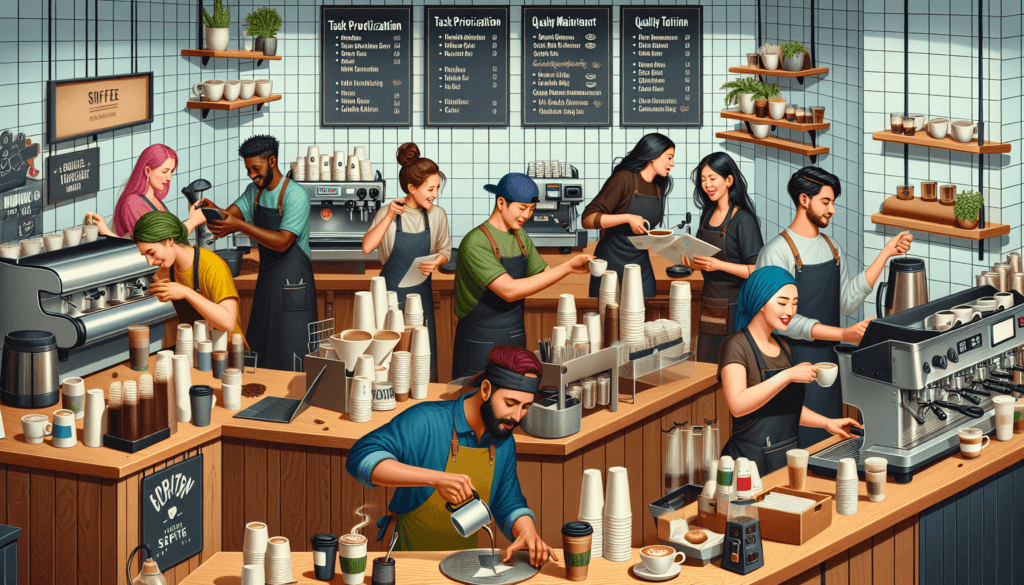Do you find yourself feeling overwhelmed when the line at your favorite coffee shop is out the door and orders are piling up? Don’t worry, we’ve got you covered. In this article, we will share some valuable tips that will help you successfully juggle multiple orders in a busy coffee shop. From staying organized to managing your time effectively, these tips will ensure that you can keep up with the demands of a bustling coffee shop while delivering excellent service to your customers. So, grab a cup of coffee and let’s get started!

1. Organizing Your Workstation
1.1 Clearing and Cleaning the Workspace
A clean and clutter-free workspace is essential for efficiency in a busy coffee shop. Take a few minutes before your shift to clear any unnecessary items and wipe down the counters. This not only creates a visually appealing environment but also allows for easy access to tools and equipment.
1.2 Setting up the Necessary Tools and Equipment
Before the rush begins, ensure that all the tools and equipment you need are readily available. This includes things like espresso machines, grinders, milk pitchers, and various brewing equipment. Arrange them in a way that makes them easily accessible, minimizing the time spent searching for items during order preparation.
1.3 Arranging Ingredients and Supplies
Proactively organize the ingredients and supplies you will need for the day. This includes coffee beans, syrups, sweeteners, cups, lids, and stirrers. Keeping everything in its designated place not only saves time but also helps in maintaining a consistent workflow.
1.4 Creating a System for Order Preparation
Establishing a systematic approach to order preparation is crucial for managing multiple orders efficiently. Consider using a checklist or digital order management system to keep track of incoming orders, their status, and any special customer requests. This will help you stay organized and ensure a smooth workflow.
2. Prioritizing and Managing Orders
2.1 Assessing Order Complexity and Time Requirement
Each order that comes in may differ in terms of complexity and the time required for preparation. Take a moment to evaluate the orders, considering factors such as the number of items, customization options, and brewing techniques. This assessment will help you prioritize the orders effectively.
2.2 Establishing Order Priorities
Once you have assessed the orders, establish a clear system for order priority. This could be based on the order in which they were received, the complexity of the order, or any specific customer requests. Prioritizing orders allows you to ensure that each customer receives their drink in a timely manner.
2.3 Communicating with Customers
Maintaining good communication with customers is essential for managing their expectations and providing excellent service. If there is a delay in their order or an item is unavailable, inform them promptly and offer alternatives or estimated wait times. Effective communication helps build trust and ensures customer satisfaction.
2.4 Utilizing Technology and Order Management Systems
Investing in technology such as order management systems can greatly assist in efficiently managing multiple orders. These systems allow you to easily track and update order statuses, communicate with customers, and coordinate with the rest of the team. Utilizing technology can streamline the ordering process and reduce the chances of errors or missed orders.

3. Developing Efficient Workflow
3.1 Streamlining the Order Process
To maintain a smooth workflow, identify any bottlenecks or unnecessary steps in the order process and find ways to streamline them. This could involve reorganizing equipment or changing the sequence of tasks. By optimizing the workflow, you can save time and serve customers more efficiently.
3.2 Utilizing Techniques for Time Management
Time management techniques such as batching similar orders together or multitasking can help improve efficiency. For example, while waiting for an espresso shot to extract, you can simultaneously prepare another order or clean the workstation. Smart time management ensures that you make the most of your available time without compromising quality.
3.3 Creating Clear Communication Channels
Effective communication is crucial for a well-coordinated team and smooth order management. Establishing clear communication channels with your colleagues ensures that everyone is on the same page and can easily exchange information about order statuses, customer requests, and any issues that arise. This reduces confusion and helps prevent errors.
3.4 Delegating Tasks when Appropriate
In a busy coffee shop, it’s important to recognize when and how to delegate tasks. If you have capable colleagues or support staff available, assign tasks such as restocking supplies, preparing certain components of drinks, or handling customer questions. Delegating tasks can help alleviate your workload and allow you to focus on order preparation.
4. Ensuring Accuracy and Quality
4.1 Paying Attention to Details
Maintaining attention to detail is crucial to ensure accuracy and quality in every order. Double-checking measurements, following recipes precisely, and checking for any customer-specific requests can make a significant difference. By paying attention to details, you can consistently deliver delicious beverages that meet or exceed customer expectations.
4.2 Practicing Quality Control
Continuously monitoring the quality of your drinks is essential. Taste-test each drink before handing it out to customers, ensuring that it meets the expected standards. Regularly calibrate your equipment to ensure consistent brews and train your palate to detect any errors or deviations in taste. Quality control ensures that every customer receives an exceptional cup of coffee.
4.3 Regularly Updating Product Knowledge
Staying up-to-date with the latest information about coffee varieties, brewing techniques, and flavor profiles is essential for providing customers with accurate information and recommendations. Dedicate time to reading industry publications, attending workshops, and experimenting with new brewing methods. An informed barista can create unique experiences for customers and stay ahead in the ever-evolving coffee industry.
4.4 Seeking Feedback and Continuous Improvement
Actively seek feedback from customers to understand their preferences, identify areas for improvement, and address any concerns. Encourage customers to share their thoughts and be open to constructive criticism. Regularly assess your own performance and seek opportunities for growth. Continuous improvement ensures that you consistently provide the best possible experience for your customers.

5. Managing Customer Expectations
5.1 Setting Realistic Wait Times
Setting realistic wait times for orders is crucial for managing customer expectations. Evaluate the workload, the complexity of the orders in the queue, and the current staffing level to estimate wait times accurately. Communicate these wait times to customers to manage their expectations and avoid disappointment.
5.2 Providing Updates on Order Progress
Keeping customers informed about the progress of their orders is essential for customer satisfaction. Regularly update them on the status of their order, especially if there are any delays. This demonstrates transparency and ensures that customers feel valued and informed throughout their wait.
5.3 Offering Alternatives and Suggestions
If a customer’s desired item is not available or there is a delay due to unforeseen circumstances, be prepared to offer alternatives or suggestions. Having a good understanding of your menu and being able to recommend similar options or seasonal specialties can turn a potentially disappointing situation into a delightful surprise for the customer.
5.4 Handling Customer Complaints and Dissatisfaction
Despite our best efforts, there may be instances where a customer expresses dissatisfaction or lodges a complaint. It is crucial to handle such situations calmly and professionally. Listen attentively, empathize with their concerns, and find a suitable solution. Resolving customer issues promptly and courteously can help turn a dissatisfied customer into a loyal advocate for your business.
6. Maintaining a Positive Attitude
6.1 Managing Stress and Staying Calm
Working in a busy coffee shop can be demanding and stressful, but it’s important to maintain a positive attitude. Learn strategies to manage stress, such as deep breathing exercises, taking short breaks, or focusing on the rewarding aspects of your job. Staying calm and composed in challenging situations allows you to provide excellent service to customers.
6.2 Practicing Good Communication and People Skills
Effective communication and good people skills are essential for creating a positive atmosphere in the coffee shop. Greet customers with a friendly smile, engage in polite conversation, and actively listen to their needs. Clear communication and a personable approach contribute to a welcoming environment that keeps customers coming back.
6.3 Promoting Teamwork and Collaboration
A supportive and collaborative team can make all the difference in managing a busy coffee shop. Foster teamwork by encouraging open communication, sharing knowledge and skills, and genuinely supporting your colleagues. By working together, you can tackle challenges more efficiently and provide exceptional service to your customers.
6.4 Celebrating Success and Personal Achievements
Take the time to celebrate both team and personal achievements. Recognize and acknowledge the hard work and dedication that goes into managing multiple orders successfully. Celebrating successes, big or small, boosts morale, motivates the team, and creates a positive work environment.

7. Honing Barista Skills
7.1 Mastering Espresso Shots and Milk Steaming
Being a skilled barista requires mastering the art of pulling the perfect espresso shot and steaming milk to achieve the desired texture and consistency. Invest time in practicing these skills, experimenting with different espresso beans and techniques, and fine-tuning your milk steaming capabilities. A well-executed shot and expertly steamed milk form the foundation of exceptional coffee beverages.
7.2 Perfecting Latte Art and Beverage Presentation
Latte art adds a delightful touch to the presentation of coffee beverages. Develop your latte art skills by experimenting with various pouring techniques and patterns. A visually appealing beverage showcases your craftsmanship and enhances the overall customer experience.
7.3 Expanding Knowledge of Coffee Varieties
Deepen your knowledge of different coffee varieties, regions, and flavor profiles. Understand the characteristics and unique qualities of beans from various origins. Expand your palate by sampling different coffees and consistently honing your tasting skills. This expertise allows you to recommend coffees that align with customers’ preferences and interests.
7.4 Continuously Improving Speed and Efficiency
Strive for continuous improvement in your speed and efficiency without compromising the quality of your drinks. Practice time-saving techniques, such as mastering the simultaneous execution of tasks and minimizing wasted movements. Efficiency allows you to serve customers promptly, reducing wait times and increasing customer satisfaction.
8. Staying Organized and Prepared
8.1 Maintaining a Well-Stocked Inventory
Regularly check and restock your inventory to ensure that you have an adequate supply of all necessary ingredients and supplies. Create a system for monitoring inventory levels, placing orders in a timely manner, and keeping track of any expired or low-quality items. A well-stocked inventory ensures a smooth workflow and minimizes disruptions.
8.2 Planning for Busy Periods and Rush Hours
Anticipate and plan for busy periods and rush hours by analyzing historical data and other factors such as events or seasonal fluctuations. Staff accordingly, adjust inventory levels, and be prepared to handle higher order volumes efficiently. Planning ahead allows you to manage the influx of orders and provide excellent service, even during peak times.
8.3 Creating Checklists and To-Do Lists
Create checklists or to-do lists to help you stay organized and ensure that all tasks are completed. This can include tasks such as restocking supplies, cleaning equipment, preparing specific components of drinks, or attending to maintenance. Checklists serve as a visual guide that helps you manage your time effectively and prevents important tasks from being overlooked.
8.4 Keeping Track of Order History and Customer Preferences
Maintain a record of order history and customer preferences to personalize future interactions and recommendations. This can be done using a digital system or even a simple notebook. By keeping track of customer preferences, you can create memorable experiences, foster customer loyalty, and exceed expectations.

9. Managing Team and Time
9.1 Communicating and Collaborating with Colleagues
Open and effective communication with your colleagues is crucial for a well-managed and efficient coffee shop. Regularly communicate with your team to share important updates, discuss any challenges, and coordinate tasks. Collaboration and mutual support help create a harmonious and thriving work environment.
9.2 Effectively Scheduling Work Shifts
Creating an effective work schedule is essential for ensuring adequate coverage during busy periods and maintaining a healthy work-life balance for the team. Consider factors such as individual availability, skill sets, and peak customer traffic when scheduling shifts. A well-designed schedule minimizes understaffed shifts and fosters happier and more productive employees.
9.3 Training and Cross-Training Staff
Invest in training and cross-training your staff to ensure that multiple team members can handle different tasks and responsibilities. This flexibility allows for efficient task delegation, reduces dependency on specific individuals, and minimizes disruptions caused by absences or unexpected situations. Training also contributes to the professional growth and job satisfaction of your team members.
9.4 Regularly Assessing and Adjusting Staffing Levels
Regularly evaluate the staffing levels based on customer demand and order volumes. Analyze historical data, monitor wait times, and seek feedback from both customers and staff to identify patterns or areas needing improvement. Adjusting staffing levels accordingly ensures that you can handle order volumes effectively and maintain high levels of customer satisfaction.
10. Embracing Continuous Learning
10.1 Attending Coffee Workshops and Training Sessions
Participate in coffee workshops, training sessions, and industry events to further enhance your knowledge and skills. These opportunities allow you to learn from industry experts, discover new brewing techniques, and stay updated with the latest trends and innovations. Continuous learning is essential for personal and professional growth in the dynamic world of coffee.
10.2 Reading Industry News and Publications
Stay informed about industry news and trends by reading coffee-focused publications, blogs, and websites. Pay attention to articles about new brewing methods, emerging coffee regions, and sustainability initiatives. This knowledge not only expands your understanding but can also be shared with customers, enabling more engaging and informative interactions.
10.3 Learning from Peers and Networking
Develop relationships with other coffee professionals and engage in conversations to learn from their experiences and perspectives. Participate in local or online coffee communities, join barista networks or forums, and attend networking events. Collaborating and sharing knowledge with peers fosters growth, inspires creativity, and allows for mutual support within the coffee industry.
10.4 Experimenting with New Techniques and Recipes
Continuously challenge yourself by experimenting with new brewing techniques, recipes, and flavor combinations. This can involve trying different coffee extractions, exploring alternative milk options, or incorporating unique ingredients. Experimentation pushes boundaries, broadens your skill set, and allows you to offer customers exciting and innovative beverages.


